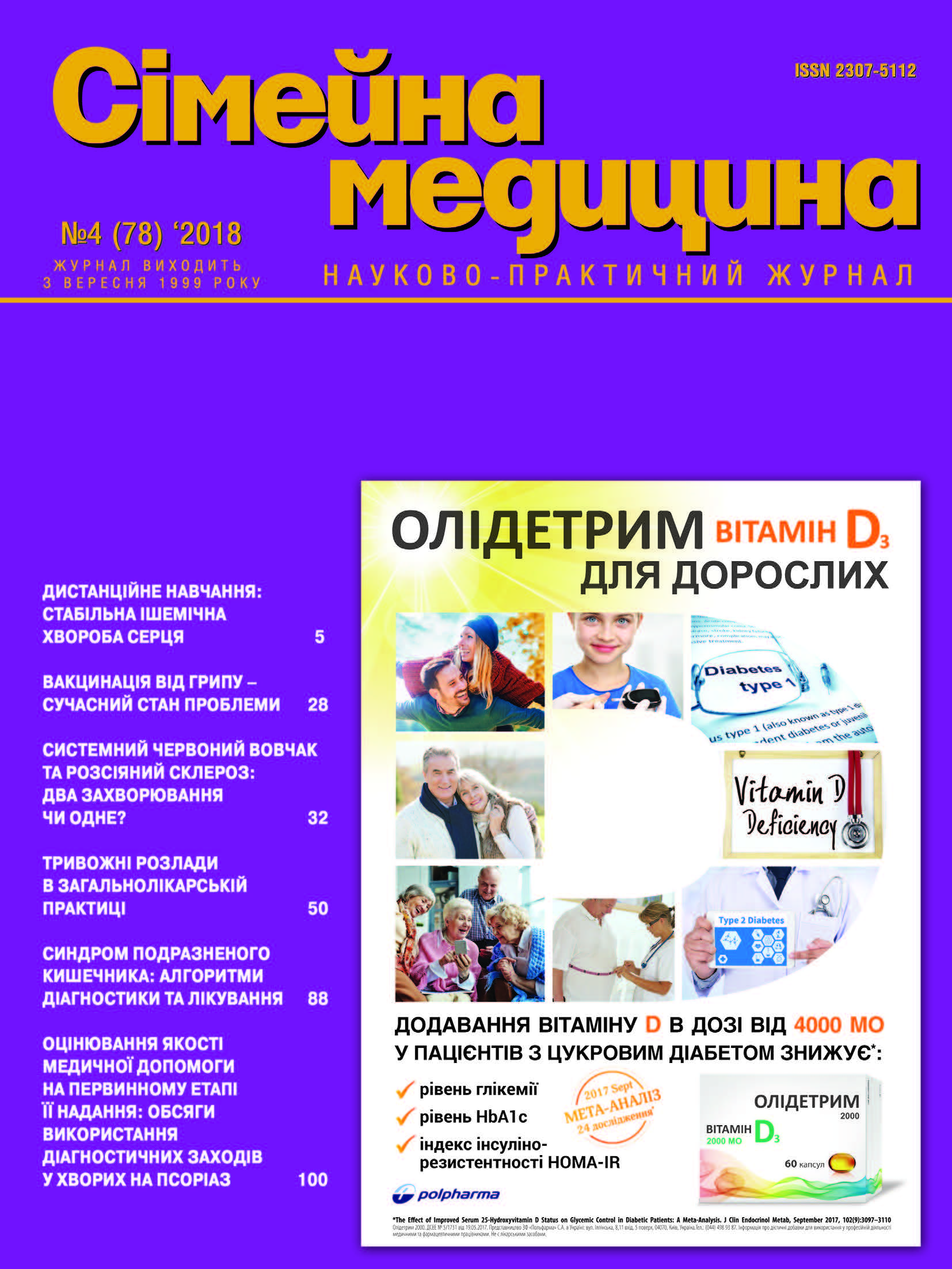Method for the Predicting Renal Failure Progression in Patients with Essential Arterial Hypertension I Stage
##plugins.themes.bootstrap3.article.main##
Abstract
The article deals with the method of improving the prognosis of kidney damage in patients with essential arterial hypertension І stage. The principle of the method of forecasting, its advantages of use in clinical practice is described. The indexes of dynamic series, stability estimation on the value of rank correlation with the subsequent construction of the regression model of forecasting, determination of its significance by the level of determination are given.
The objective: to improve the way of predicting the risk of developing kidney damage in patients with EH I stage.
Materials and methods. The study was attended by 129 patients. The main group consisted of 101 patients diagnosed with essential arterial hypertension I stages according to the diagnostic criteria of the WHO/ISH, 2003 (World Health Organization/International Society of Hypertension) and Order of the Minister of Health from May, 24, 2012 No.384 [2, 4, 9]. (the average duration of the EH I stage is 3,7 ±2,1 years, women – 31 (30,7%), men – 70 (69,3%), middle age – 41,0 [33,0-47,0] years); 28 practically healthy persons in relation to the main group as a control group (women – 17 (60,7%), men – 11 (39,3%), middle age – 37,0 (31,0-46,0) years. The following criteria were not included: symptomatic arterial hypertension, valve heart failure, rhythm disturbance, chronic heart failure, chronic kidney disease, diabetes mellitus, ischemic heart disease, patients in the main group did not take antihypertensive therapy. All patients were followed by the following examinations: clinical examination, general clinical blood tests and urine, biochemical blood test (total protein, urea, creatinine, glucose, lipid profile); daily monitoring of AT (DMAT), ECG, Echo-KG and ultrasound of carotid arteries, ophthalmoscopy; and determination of renal function reserve (RFR) water and salt load (according to the Ukrainian patent number 1133692.) [3]. The statistical processing of the results was carried out using Microsoft Excel 2016, an application suite of statistical analysis software IBM SPSS Statistics 20 using a variety of methods of parametric and nonparametric statistics.
Results. A prognostic regression model was built, which will help to identify patients with a high risk of kidney damage in stage EH I stage. It was revealed that the most significant factors determining the prognosis of the development of kidney damage during EH are age, gender (male), blood creatinine, rSHCFreat, and the level of DBP.
Conclusion. The application of the developed and proposed prediction method will increase the accuracy of the assessment of the probability of development of kidney damage in patients with EH I stage, which will provide an adequate definition of the further tactics of patient management at the stage of primary care with the appointment of a corresponding complex of additional examinations, and therefore, more correct treatment.##plugins.themes.bootstrap3.article.details##

This work is licensed under a Creative Commons Attribution 4.0 International License.
Authors retain the copyright and grant the journal the first publication of original scientific articles under the Creative Commons Attribution 4.0 International License, which allows others to distribute work with acknowledgment of authorship and first publication in this journal.
References
Електронний документ «Надання медичної допомоги хворим на хронічну хворобу нирок V стадії, які лікуються гемодіалізом. Адаптована клінічна настанова, заснована на доказах», 2015. PDF
Наказ МОЗ України № 384 від 24.05.2012 «Про затвердження та впровадження медико-технологічних документів зі стандартизації медичної допомоги при артеріальній гіпертензії»: Офіційний сайт [Електронний ресурс] // Міністерство охорони здоров’я України. – Режим доступу http://old.moz.gov.ua/ua/portal/dn_20120524_384.html
Хіміон Л.В. Пат. № 1133692 від 10.02.2017 р., Бюлетень № 3 «Спосіб визначення функціонального ниркового резерву у хворих на есенціальну артеріальну гіпертензію» / Хіміон Л.В., Тимощук Л.С. http://uapatents.com/5-113692-sposib-viznachennya-funkcionalnogo-nirkovogo-rezervu-u-khvorikh-na-esencialnu-arterialnu-gipertenziyu.html
Guidelines Committee. 2003 World Health Organization (WHO)/International Society of Hypertension (ISH) statement on management of hypertension // J. Hypertens. 2003; 21: 1983–1992. https://doi.org/10.1097/01.hjh.0000084751.37215.d2
Kidney Disease: Improving Global Outcomes (KDIGO) CKD Work Group. KDIGO 2012 Clinical Practice Guideline for the Evaluation and Management of Chronic Kidney Disease // Kidney inter., Suppl. 2013; 3: 1–150. https://doi.org/10.1038/kisup.2012.73
Kearney P.M., Whelton M., Reynolds K., et al. Global burden of hypertension: analysis of worldwide data // Lancet. 2005;365: 217–23. https://doi.org/10.1016/S0140-6736(05)17741-1
Matsushita K, van der Velde M, Astor BC, et al /Association of estimated glomerular filtration rate and albuminuria with all-cause and cardiovascular mortality in general population cohorts: a collaborative meta-analysis. Lancet. 2010;375: 2073–2081. https://doi.org/10.1016/S0140-6736(10)60674-5
Sung KC, Ryu S, Lee JY, et al. Urine albumin/creatinine ratio below 30 mg/g is a predictor of incident hypertension and cardiovascular mortality. J Am Heart Assoc. 2016; 5: e003245. https://doi.org/10.1161/JAHA.116.003245
World Health Organization-International Society of Hypertension Guidelines for the Management of Hypertension. Guidelines Subcommittee // J. Hypertens. 1999; 17: 151–183.
ESH/ESC Guidelines for the management of arterial hypertension The Task Force for the management of arterial hypertension of the European Society of Hypertension (ESH) and of the European Society of Cardiology (ESC) / G. Mancia, R. Fagard, K. Narkiewicz [et al.] // Eur. Heart J. – 2013. – Vol. 34 (28). – P. 2159–2219. https://doi.org/10.1093/eurheartj/eht151





